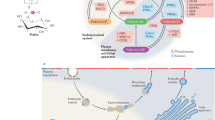Abstract.
Membrane trafficking is crucial in the homeostasis of the highly compartmentalized eukaryotic cells. This compartmentalization occurs both at the organelle level, with distinct organelles maintaining their identities while also intensely interchanging components, and at a sub-organelle level, with adjacent subdomains of the same organelle containing different sets of lipids and proteins.Acentral question in the field is thus how this compartmentalization is established and maintained despite the intense exchange of components and even physical continuities within the same organelle. The phosphorylated derivatives of phosphatidylinositol, known as the phosphoinositides, have emerged as key components in this context, both as regulators of membrane trafficking and as finely tuned spatial and temporal landmarks for organelle and sub-organelle domains. The central role of the phosphoinositides in cell homeostasis is highlighted by the severe consequences of the derangement of their metabolism caused by genetic deficiencies of the enzymes involved, and from the systematic hijacking of phosphoinositide metabolism that pathogens operate to promote their entry and/or survival in host cells. (Part of a Multi-author Review)
Similar content being viewed by others
Author information
Authors and Affiliations
Corresponding author
Rights and permissions
About this article
Cite this article
Vicinanza, M., D’Angelo, G., Di Campli, A. et al. Membrane traffic in the secretory pathway. Cell. Mol. Life Sci. 65, 2833–2841 (2008). https://doi.org/10.1007/s00018-008-8353-2
Published:
Issue Date:
DOI: https://doi.org/10.1007/s00018-008-8353-2




